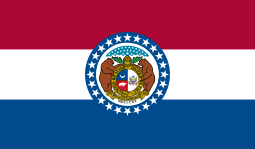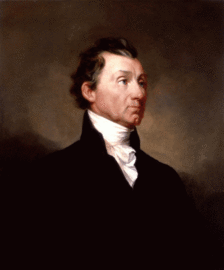United States presidential election in Missouri, 1820
United States presidential election in Missouri, 1820

|
| November 1 – December 6, 1820 |
|
|
|
|
|
This article describes the United States presidential election, 1820, in Missouri. In this first year, the state's electors were pledged to the eventual winner, James Monroe, by the state legislature. It was the first year Missouri cast ballots for the electoral college.
Statehood and electoral vote dispute
On March 6, 1820, Congress had passed a law directing Missouri to hold a convention to form a constitution and a state government. This law stated that “…the said state, when formed, shall be admitted into the Union, upon an equal footing with the original states, in all respects whatsoever.”[1] However, when Congress reconvened in November 1820, the admission of Missouri became an issue of contention. Proponents claimed that Missouri had fulfilled the conditions of the law and therefore it was a state; detractors contended that certain provisions of the Missouri constitution violated the United States Constitution.
By the time Congress was due to meet to count the electoral votes from the election, this dispute had lasted over two months. The counting raised a ticklish problem: if Congress counted Missouri's votes, that would count as recognition that Missouri was a state; on the other hand, if Congress failed to count Missouri's vote, that would count as recognition that Missouri was not a state. Knowing ahead of time that Monroe had won in a landslide and that Missouri's vote would therefore make no difference in the final result, the Senate passed a resolution on February 13, 1821 stating that if a protest were made, there would be no consideration of the matter unless the vote of Missouri would change who would become President. Instead, the President of the Senate would announce the final tally twice, once with Missouri included and once with it excluded.[2]
The next day this resolution was introduced in the full House. After a lively debate, it was passed. Nonetheless, during the counting of the electoral votes on February 14, 1821, an objection was raised to the votes from Missouri by Representative Arthur Livermore of New Hampshire. He argued that since Missouri had not yet officially become a state that Missouri had no right to cast any electoral votes. Immediately, Representative John Floyd of Virginia argued that Missouri's votes must be counted. Chaos ensued, and order was only restored with the counting of the vote as per the resolution and then adjournment for the day.[3]
References
- ↑ United States Congress (1820). United States Statutes at Large. Act of March 6, ch. 23, vol. 3. pp. 545–548. Retrieved 2006-08-09.
- ↑ United States Congress (1821). Senate Journal. 16th Congress, 2nd Session, February 13. pp. 187–188. Retrieved 2006-07-29.
- ↑ Annals of Congress. 16th Congress, 2nd Session, February 14, 1821. Gales and Seaton. 1856. pp. 1147–1165. Retrieved 2006-07-29.

